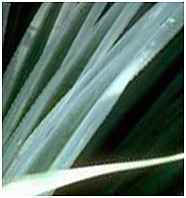From Native American folk remedy to modern-day prostate and urologic aid
Saw Palmetto (Serenoa repens) is used in several forms of traditional medicine. Native tribes of Florida such as the Seminoles relied on saw palmetto berries for food, and the Mayans drank it as a tonic; however, Europeans often found the taste of the berries objectionable.
 Historically, Saw Palmetto was taken with nettle root and pumpkin seeds. Thus, some modern formulations include these elements. Native American medicine men also reputedly kept a medicine bag of Saw Palmetto around to make antiseptic and a tonic, and to treat a wide variety of conditions, including impotence, inflammation and infertility, and as an expectorant.
Historically, Saw Palmetto was taken with nettle root and pumpkin seeds. Thus, some modern formulations include these elements. Native American medicine men also reputedly kept a medicine bag of Saw Palmetto around to make antiseptic and a tonic, and to treat a wide variety of conditions, including impotence, inflammation and infertility, and as an expectorant.
Saw Palmetto has historically been used to treat infertility in women and underdeveloped breasts. It has also been used to increase lactation, mitigate painful menstruation cycles, and reduce the size of an enlarged prostate. It has even been used as an appetite stimulant.
A crude extract of Saw Palmetto was used for at least 200 years for various conditions including asthenia (weakness), recovery from a major illness, and urogenital problems.
Medicinal use of Saw Palmetto was introduced into Western medical practice in the 1870s and was a favorite of eclectic medical practitioners for prostate and other urologic conditions. For instance, the eclectic medicine practitioner H. W. Felter wrote of it, “Saw Palmetto is a nerve sedative, expectorant, and a nutritive tonic, acting kindly upon the digestive tract…Its most direct action appears to be upon the reproductive organs when undergoing waste of tissue…”
During the late 19th century interest in Saw Palmetto developed when its positive effect on livestock was observed. This interest increased when its beneficial effects on the genitourinary tract were noted. At this time Saw Palmetto was used as a treatment for enlarged prostate, cystitis, gonorrhea, and irritation of the mucous membranes.
Saw Palmetto berries were officially included in the US Pharmacopeia in 1906 and 1916, and in the National Formulary from 1926 to 1950. However, after the World War II era, the use of Saw Palmetto as a medication diminished in the United States.
Despite this decline in the US, use of Saw Palmetto as a medicinal herb continued in Europe. Currently, the use of herbal alternatives for the treatment of benign prostatic hyperplasia (BPH) is very common there. This is most prevalent in Germany, whereas many as 95% of patients are first treated with an herbal remedy. Treatment with herbal remedies has provided a more favorable ratio between therapeutic benefits and adverse reactions. In Germany, a standard has been set such that Saw Palmetto extract must contain 85-95% fatty acids and sterols (used as biomarkers and believed to be the active ingredients). It is this lipophilic extract that has been used throughout Europe and upon which the majority of Saw Palmetto research has been performed.
In recent years, the United States has seen a resurgence of interest in using Saw Palmetto extract for the treatment of many “male-oriented” disorders such as impotence, hair loss, male pattern baldness, enlargement of the prostate, BPH and even sexual dysfunctions and poor libido.
Early research indicated that the extract is well-tolerated and suggested “mild to moderate improvement in urinary symptoms and flow measures.” Later trials of higher methodological quality indicated no difference from placebo. Questions of adequate blinding and delivery of any active ingredients remain.
Inhibition of both forms of 5-alpha-reductase with no reduction in cellular capacity to secrete prostate-specific antigen is indicated.
Other proposals for mechanisms of action include interfering with dihydrotestosterone binding to the androgen receptor, relaxing smooth muscle tissue similarly to alpha antagonist drugs, and acting as a phytoestrogen.
Limited in vitro and animal model studies suggest possible anti-tumor activity and potential for use in the treatment of cancer. However, these results have not been substantiated with human trials.
The Cochrane Database review (2009) concludes that “The evidence suggests that Serenoa repens provides mild to moderate improvement in urinary symptoms and flow measures. Serenoa repens produced similar improvement in urinary symptoms and flow compared to finasteride and is associated with fewer adverse treatment events.”